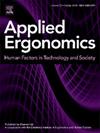Detecting bombs in hold baggage: 3D imaging is better than 2D imaging when image quality is the same
IF 3.1
2区 工程技术
Q2 ENGINEERING, INDUSTRIAL
引用次数: 0
Abstract
Three-dimensional (3D) imaging is increasingly utilized in hold baggage screening (HBS) at airports. It enables screeners to rotate images and view cross-sectional layers of the bag (slicing). Previous studies on multi-target search in cabin baggage screening indicate that novices benefit from 3D-rotatable images when image quality is the same in 2D and 3D. We investigated the effects of 3D imaging for professional screeners in HBS, where the screening task is to detect bombs in pre-alarmed bags flagged by automated explosives detection systems. In our study, 51 professional screeners completed a highly realistic HBS task involving two levels of bag complexity in 2D and 3D imaging conditions with the same image quality. We found that 3D imaging resulted in higher detection performance in terms of hit rate and sensitivity (d’ and da, two sensitivity measures of signal detection theory). Although better bomb detection was accompanied by increased response times, the practical implication of our results is that the transition to 3D HBS substantially enhances human-machine system performance in terms of both effectiveness and efficiency.
检测行李中的炸弹:在图像质量相同的情况下,3D成像优于2D成像
三维(3D)成像越来越多地应用于机场的行李寄存检查(HBS)。它使筛选器可以旋转图像并查看袋子的横截面层(切片)。以往对机舱行李筛查中多目标搜索的研究表明,在二维和三维图像质量相同的情况下,新手受益于3D可旋转图像。我们调查了3D成像对哈佛商学院专业安检人员的影响,安检任务是检测由自动爆炸物检测系统标记的预先报警袋中的炸弹。在我们的研究中,51名专业筛选人员在相同图像质量的2D和3D成像条件下完成了一项高度逼真的HBS任务,涉及两个级别的袋子复杂性。我们发现3D成像在命中率和灵敏度(d '和da,信号检测理论的两个灵敏度指标)方面具有更高的检测性能。虽然更好的炸弹探测伴随着更长的响应时间,但我们的结果的实际含义是,向3D HBS的过渡在有效性和效率方面大大提高了人机系统的性能。
本文章由计算机程序翻译,如有差异,请以英文原文为准。
求助全文
约1分钟内获得全文
求助全文
来源期刊

Applied Ergonomics
工程技术-工程:工业
CiteScore
7.50
自引率
9.40%
发文量
248
审稿时长
53 days
期刊介绍:
Applied Ergonomics is aimed at ergonomists and all those interested in applying ergonomics/human factors in the design, planning and management of technical and social systems at work or leisure. Readership is truly international with subscribers in over 50 countries. Professionals for whom Applied Ergonomics is of interest include: ergonomists, designers, industrial engineers, health and safety specialists, systems engineers, design engineers, organizational psychologists, occupational health specialists and human-computer interaction specialists.
 求助内容:
求助内容: 应助结果提醒方式:
应助结果提醒方式:


